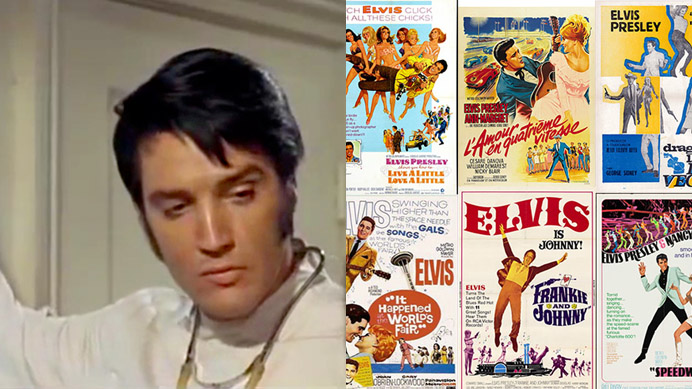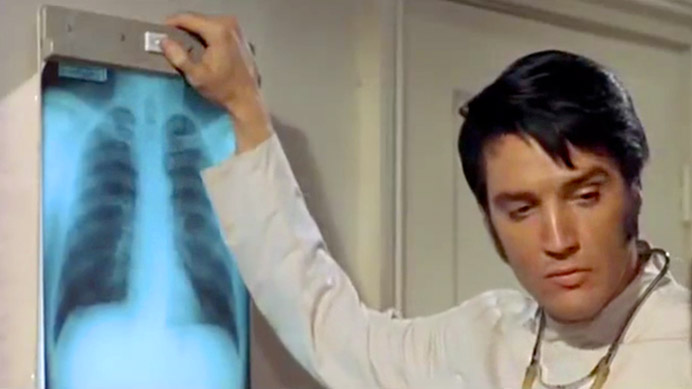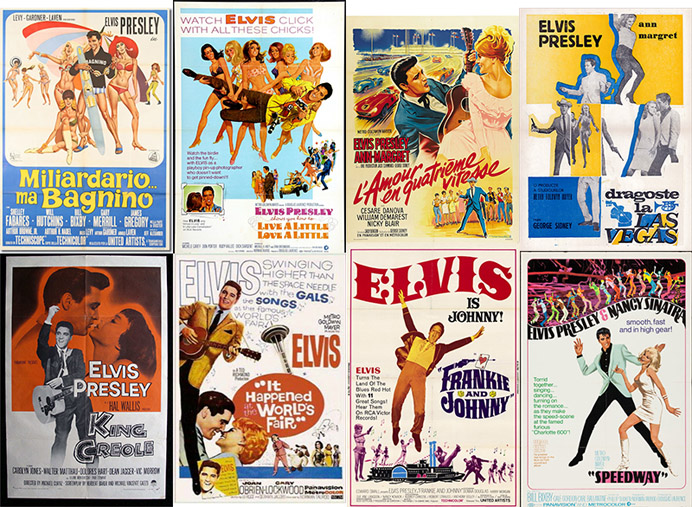
I’ve done it, guys—I did Elvis! To be specific, I did all 31 Elvis films, two a week, in about four months time. This has been a wild ride, and I thank all of you that have followed me through it.
If you remember, I set out on this journey with merely a passing fascination for Elvis, and a huge ambivalence toward his films. I finish this journey with now a plethora of Elvis film knowledge, an Elvis t-shirt, a vintage Elvis belt buckle (gifted to me randomly!), copies of both Peter Guralnick Elvis biographies (Last Train to Memphis and Careless Love: The Unmaking of Elvis Presley) and a small collection of very attractive Elvis JPEGs saved on my desktop.
I like to think that this project has changed me for the better—I now know what it’s like to soar with Elvis at his highest highs, and cringe for him at his lowest lows. I did genuinely have a lot of fun with these; there’s something very watchable about these movies, which I can’t say for most crappy ‘60s films. I’m sure it would have been a different experience had I been there when they were coming out, but to view them as a retrospective has been a real trip.
Elvis was just fun—he embodied that pure, unfettered, visceral feeling of singing and dancing your heart out. It was that force that made sequin jumpsuits look cool and shaking your ass look manly. Heck, he even made womanizing look like fun for everyone. And his movies, like himself, were equally as unpretentious and easy to digest. While the plots were often inane and the music quality dropped severely throughout, you always came wanted to come back and see what Elvis was up to this time. Some of these are worth sitting through just for that one song, or that one performance, or one scene of Elvis kissing three brides on the mouth before he gives them away to their husbands on their wedding day. I now truly understand how Elvis became such a larger-than-life presence– that unachievable ideal that eventually brought Elvis himself to his knees.
But I digress. Lets take one last trip though Elvis film-review-land with his 31st and final film:

Change of Habit (1969) | 93 min.
Sister Michelle (Mary Tyler Moore), Sister Irene (Barbara McNair) and Sister Barbara (Jane Elliot) are chosen by the church to go on a top secret mission to infiltrate the ghetto. They are sent incognito—disguised as three unassuming, normal women who show up at a doctor’s office to pose as extra help. That doctor just so happens to be Dr. John Carpenter (Elvis Presley); a southern-accented, no-nonsense, musically-gifted, tall-dark-and-handsome man. He’s suspicious at first, and thinks these three women look too weak and innocent to make it in this tough part of town. “Diplomacy here starts with a switchblade knife. Two of the previous nurses were raped, one against her will,” he says with a wink. (Groan.)
The rest of the film revolves mostly around John’s regular patients and the nurses doing their best to better the neighborhood. We meet Julio (Nefti Millet) a teenager with a speech impediment who enjoys holding knives (nothing suspicious there). Michelle takes him on as her patient and has him come in for speech therapy every week.
There is also a girl named Amanda (Lorena Kirk) who acts deaf and mute, though John suspects she’s autistic. He treats her with “rage reduction,” or, what was known at the time as, Holding Therapy. This entails forcefully hugging the child who refuses to touch or make eye contact with you and telling them “I love you” until they scream, cry and struggle for hours, eventually tiring and then I guess just getting over their autism? That’s what happens here at least. To view this scene now feels fairly cruel, but then again, so was the 1960s definition of Autism—a disorder thought to have been brought on by having a cold and unloving mother (thanks, ’60s male doctors).
Meanwhile, Sister Irene is sent out to make house calls. Irene is the least thrilled to be in the neighborhood, as she says she grew up in a similar setting and joined the convent to escape it. At one point she argues with some black power guys who challenge her on disowning her race and heritage. There’s also Sister Barbara, who starts a boycott of the local grocery store when she realizes the cashier has been ripping off people of color. John and Michelle, of course, start to fall for each other, but he doesn’t know she’s actually a nun. Julio notices this budding romance and gets jealous.
The local Father decides he hates all three secret nuns because they listen to secular music and treat people of color as equals. It is decided that the three women are becoming too casual, and they’re ordered to put their habits back on. Michelle fights hard against it, she says there’s more undercover work to be done. But she is overruled, and all three nuns return to their flat in full nun garb. Michelle, dressed in black and white, approaches John to apologize for not telling him sooner. He feels hurt and betrayed—he spent half the movie hitting on her and couldn’t figure out why it wasn’t working. Now he realizes what she meant when she said she had ‘somebody else.’
Before they go, the nuns decide to throw a block party for San Juan de Cheguez. A local loan shark mobster called The Banker (Robert Emhardt) shows up and demands Sister Irene pay back the loan she took from him to fund the festival. She tells him she refuses to pay him back and announces to everybody there that all of their debts are now paid. The Banker punches her in the face, a fight breaks out, and the two black power dudes come to Irene’s rescue. Nobody gets arrested, and the cops all look the other way because punching a nun is wack.
Later, Michelle walks home and gets dressed for bed. Julio jumps through her window and attempts to rape her at knifepoint (FYI—this is somehow a G-rated movie) but John hears her screams and punches Julio out. Time passes, and we see John visiting Michelle at the convent. We find out Barbara has left the convent to be a part of ’60s protest movements. Michelle, meanwhile, is still struggling with her feelings for John. The movie ends with everybody in church singing, and Michelle’s eyes darting from the statues of Jesus and Mary to John’s face—we do not know which she chooses.
What a waste of talent. Here you have a dream team of Mary Tyler Moore and Elvis Presley in what easily could have been the Viva Las Vegas of uplifting sociopolitical drama. Instead, it’s a half-baked after school special about nuns. I almost want to be nicer to this movie, knowing it’s Elvis’ last, but I just can’t help but be shocked at how insincere it is—especially in 1969, a year full of sincere and brutally honest cinema: Easy Rider, Midnight Cowboy, They Shoot Horses, Don’t They?, Kes, and Z, just to name a few game changers.
I know this is my cynicism talking, but the last thing anybody wanted to hear in 1969 was a sermon about we should try harder to be better within the confines of rules forced upon us from ‘higher powers’ (corporal or otherwise). This film is the literal antithesis of the year 1969—a year of revolt, disenchantment, and social revolution. And while this film does not have a chastising tone (I won’t completely throw it under the bus, as the nuns are all depicted as genuine people who want to do good), it certainly isn’t honest about its depiction of the ghetto, or its belief in social change. Plus, its message that good intentions can somehow fix socioeconomic barriers just comes off as completely tone-deaf.
Am I being too harsh on an Elvis movie? Sure I am. I understand this movie was meant to be a splash of optimism in a sea of pessimism. They do attempt to show a level of depth with the local neighborhood inhabitants—I like that one of the nuns attempts to organize a protest based on how unfairly she sees the local grocer treat his Hispanic customers. I liked that there was a semi-positive nod to the black power movement. Julio is shown to have become disturbed from his violent father who doesn’t understand his needs. And they throw a spotlight on the out-of-touch, racist old guard of white church culture. I’ll even say it’s well-intentioned to show that even after the attempted rape, Mary Tyler Moore’s character makes a point to not press charges against the troubled young man, for he knows not what he does (or something). These nuns are shown to do well by this community because they make an effort to know and love the people around them.
However, while all of the nuns grow as people, evolving in their understanding of themselves and their faith, the film drops the ball by implying that the neighborhood somehow evolves and betters itself from their influence. By the end of the movie, everybody’s in Church, the people learn how to better keep up appearances, the neighborhood girls learn how to dress like ladies, and heck, even the autistic girl is ‘cured.’ To imply that problems of poverty, violence, crime, and racism were solved simply with ice cream, carousels, touch football, block parties, and proclamations of love is simply a product of the insincere Hollywood model from a decade earlier. Their good intentions become a superficial band-aid over the gaping maw of social and societal wounds; the film’s attempted optimism quickly goes from uplifting to inert.
But, to change gears here, let’s focus on what we really came for—and that is Dr. Elvis Presley, M.D. This movie is, hands down, the hottest Elvis has ever looked—he’s thin, his side burns are killing it, his hair is gel-free, and he truly looks at peace. They say confidence is the most attractive quality in a person, and it sure does radiate outta Elvis in this one. Except, it’s a different type of confidence—this is Elvis at his most Zen. After the success of the ’68 comeback special and the renewal of his live shows, it’s almost as if Elvis has transcended his film career at this point. Just as the movie ends, with cuts between images of Elvis’ smiling face and Jesus’ face, Elvis, too, ascends to his heavenly throne of musical God canon—or something. I don’t know, sorry guys.
But really, it’s a pity this King Elvis Zen was wasted on this false prophet of a film, this Judas of a movie. (Okay, I’ll stop for real this time.) Elvis finally gets that dramatic role he’s been desperately begging for, and his film career ends—ugh! What a shame too, because this ’69 Elvis shows such promise—which, we all know, of course, comes to a sad conclusion a mere eight years later when Elvis dies in 1977.
Best Song: The best song in this movie is easily the funktastic song “Rubberneckin’.” It’s just Elvis jamming in his apartment, but the energy is there at least. Then there’s “Have a Happy,” which, while painfully cheesy, is kind of worth it just to look at how attractive Elvis and Mary Tyler Moore are.
1 out of 5 Stars,
3 out of 5 Elvises




Well, that’s it folks. Elvis has left the building. But before I do as well, I’ll leave you with my complete and final ranking of all 31 Elvis movies from best to worst according to my star ratings, with some consideration given to my Elvis ratings. I hope you’ve enjoyed this odyssey as much as I did, and I’d certainly encourage you to give Elvis a second look if you haven’t already:
1. King Creole
5. Roustabout
7. Loving You
9. It Happened At The World’s Fair
10. Flaming Star
11. Clambake
12. Speedway
14. Fun In Acapulco
15. Charro!
16. Blue Hawaii
17. Girl Happy
18. G.I. Blues
19. Spinout
20. Kid Galahad
21. Tickle Me
22. Harum Scarum
24. Love Me Tender
26. Change of Habit
27. Double Trouble
28. Live A Little, Love A Little
29. Kissin’ Cousins
31. Stay Away, Joe































































Back to Jenna Does Elvis #15 | Start over at Jenna Does Elvis #1
Bummed to see this come to a close, but I enjoyed it every step of the way. If you haven’t, check out the ’81 pseudo documentary “This Is Elvis” which reviews his life shortly after he died. It’s clearly trying to write the history books on who he was and his legacy, and has some interesting behind-the-scenes stuff.
I just checked and I have five more Elvis movies to watch myself. Time to get crackin’!
Glad to hear you enjoyed it!!
Oh nice– I actually haven’t seen that one, I will definitely check it out. Thanks Danny!
The infamous psychologist Robert Zaslow consulted on the Holding Therapy scene with Elvis. It is believed to be the earliest example of this fringe therapy on film.
Holding Therapy was also called “Z Therapy” after Zaslow who came to Denver’s school for the blind claiming the practice could restore sight.. When it failed to do so, Holding Therapy was used for autism and then a wide array of real or perceived behaviors. Colorado child welfare agencies promoted and funded Holding Therapy for decades. Various styles of Holding Therapy persist decades after this film although the use of *coercive restraint as therapy* has been denounced a child abuse. It is highly unlikely that it has proved therapeutic for anyone.
There is one notable difference between the way the Elvis physician character conducts Holding Therapy and the actual training films. Elvis tries to emote as much tenderness as the scene allows; the real therapists who do Holding Therapy look like sadists.
One more thing: it appears that the so-called child actor (child with actual autism?) is not acting but sincerely distressed by the restraint. I wish Mary Tyler Moore would comment on this suspicion.
Thanks for your comment, Linda! Very interesting stuff!
I was wondering too if that child was actually autistic or not… I’d hope not just because of how alarming that scene was, but I too have my suspicions.
This is fascinating stuff. Linda, thanks a lot for chiming in!
Wow, I just found you and it’s 4 in the morning. I can’t read it all now! But this is amazing, what you’ve done. I must come back.
I fell into an Elvis vortex six or seven months ago and I cannot get out. Really, it’s…crazy. His movies are what I know least, so this is great, your particular sympathetic but critical look at them/him in them. Thank you.
Have you read Guralnick’s biography?
Thanks Emma! I think finding this at 4am is probably the best way to read it!
An “Elvis vortex” is such an apt way to put it, he really does suck you in. I’m actually half way through the first Guralnick bio as we speak– what a fascinating and fantastic read. It’s also been a great introduction to so many great country and western musicians that my city-slicker ass ain’t never even heard of. I’m really enjoying it!
Yeah, it’s a vortex alright. Very mixed for me with a lot of the personal stuff which I find hard to take. But, my God, he’s really gotten to me. I think about him so often. Also hard to find a place online where you can talk about him in a reasonable way, or what I’d call a reasonable way. I’m on YouTube a lot, of course, but it’s nuts over there, the extremes between the (literal) worship and the people who are just cruel about him. But I found you thru a comment you made on a Follow That Dream video, a comment that made me think “oh I should look what she’s writing.” So, you never know!
I really like how Guralnick writes those books. Hard, I think, to find a biographer who respects the limitations of what’s knowable about his subject. And then there’s his understanding and appreciation for the music. The second volume is rough.
I often wondered, what if they had made TV series continuing the story of the characters.
This could have been the pilot movie as so many successful series started life like this.
It could of been the challenge El was needing and would of been a nice contrast/break from the live engagement. “Too much exposure” I hear the Colonel saying, “not enough” we say.
Failing Elvis appearing in the TV series, there was always the option to substitute him with perhaps a new up and coming actor ie Kris Kristoferson perhaps or even Tony Joe White and slip in a song to boot. The TV series would of been a good advert for the movie next time it came around.
I should of been Elvis` manager.
Ha! Not a bad idea! There could have been a bunch of great Saturday Morning Cartoons at least, ala The Beatles cartoon or Yellow Submarine. I absolutely would watch that.
Yeh cartoons, they are cool too.
After visiting Graceland and watching Speedway on their big screen at the end of the tour, I was looking for a complete ranking. I think your Elvis score will help me in my viewing since of the two I’ve watched, Speedway I loved and Charro I didn’t care for. : )
Thanks!